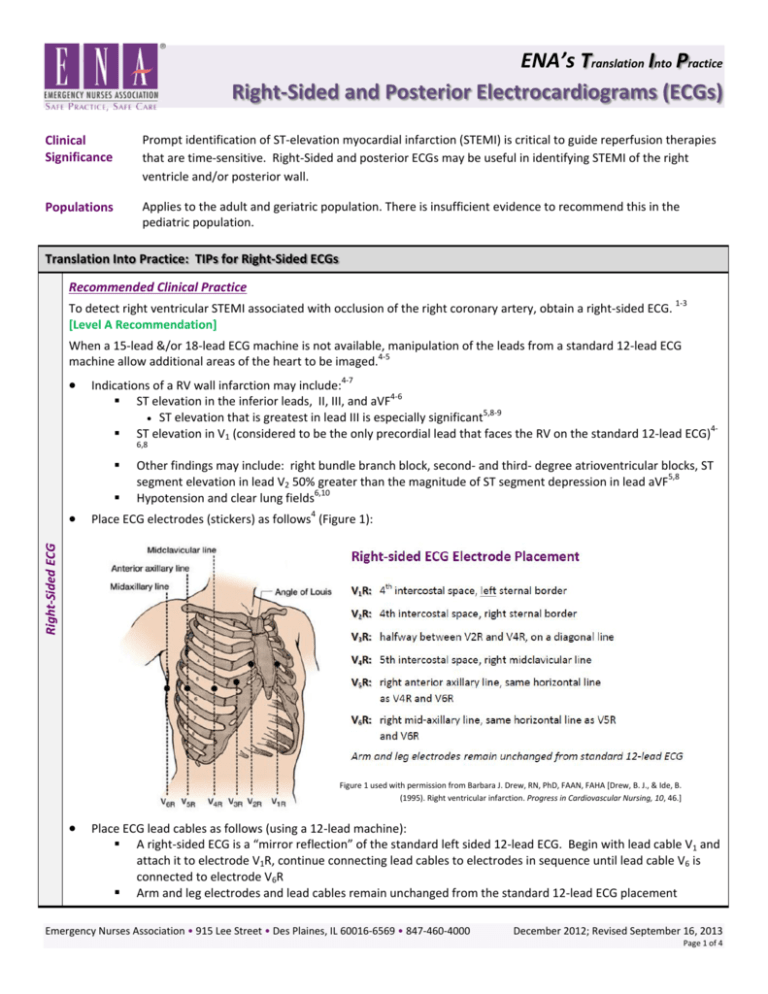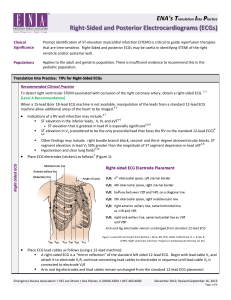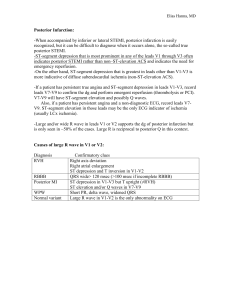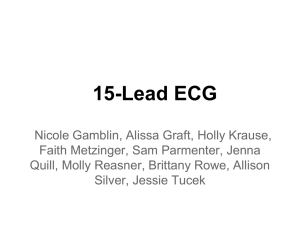Right-Sided & Posterior ECGs: Clinical Guide for STEMI Detection
advertisement

ENA’s Translation Into Practice Right-Sided and Posterior Electrocardiograms (ECGs) Clinical Significance Prompt identification of ST-elevation myocardial infarction (STEMI) is critical to guide reperfusion therapies that are time-sensitive. Right-Sided and posterior ECGs may be useful in identifying STEMI of the right ventricle and/or posterior wall. Populations Applies to the adult and geriatric population. There is insufficient evidence to recommend this in the pediatric population. Translation Into Practice: TIPs for Right-Sided ECGs Recommended Clinical Practice To detect right ventricular STEMI associated with occlusion of the right coronary artery, obtain a right-sided ECG. 1-3 [Level A Recommendation] When a 15-lead &/or 18-lead ECG machine is not available, manipulation of the leads from a standard 12-lead ECG machine allow additional areas of the heart to be imaged.4-5 Indications of a RV wall infarction may include:4-7 ST elevation in the inferior leads, II, III, and aVF4-6 5,8-9 ST elevation that is greatest in lead III is especially significant ST elevation in V1 (considered to be the only precordial lead that faces the RV on the standard 12-lead ECG)46,8 Place ECG electrodes (stickers) as follows4 (Figure 1): Right-Sided ECG Other findings may include: right bundle branch block, second- and third- degree atrioventricular blocks, ST segment elevation in lead V2 50% greater than the magnitude of ST segment depression in lead aVF5,8 Hypotension and clear lung fields6,10 Figure 1 used with permission from Barbara J. Drew, RN, PhD, FAAN, FAHA [Drew, B. J., & Ide, B. (1995). Right ventricular infarction. Progress in Cardiovascular Nursing, 10, 46.] Place ECG lead cables as follows (using a 12-lead machine): A right-sided ECG is a “mirror reflection” of the standard left sided 12-lead ECG. Begin with lead cable V1 and attach it to electrode V1R, continue connecting lead cables to electrodes in sequence until lead cable V6 is connected to electrode V6R Arm and leg electrodes and lead cables remain unchanged from the standard 12-lead ECG placement Emergency Nurses Association • 915 Lee Street • Des Plaines, IL 60016-6569 • 847-460-4000 December 2012; Revised September 16, 2013 Page 1 of 4 ENA’s Translation Into Practice Right-Sided and Posterior Electrocardiograms (ECGs) TIP: Right-Sided ECGs – continued Label the Right-sided ECG4 (Figure 2): Note “Right-sided ECG” in the machine, if able Handwrite “Right-sided ECG” on the 12-lead ECG printout if not already part of the electronic printout Re-label V1 – V6 on the printout to V1R – V6R Presence of a right ventricular wall infarction is seen when there is ST elevation greater than 1 mm in V4R 5,11 Right-Sided ECG Figure 2: Labeling the Right-Sided ECG Right-Sided ECG Supporting Rationale: Right-Sided ECGs Up to 50% of patients with an inferior wall MI may have RV infarction or ischemia 6,16 Occlusion of the right coronary artery proximal to the right ventricular branch is associated with inferior wall MI involving the RV1-3,5,8-9,11,16 In approximately 10% of the population, the left circumflex artery supplies the right ventricle and may therefore cause an associated lateral wall MI in conjunction with the RV infarction5,8 Patients with coexisting RV infarct have more myocardium involved, increasing their risk of complications up to and including death8,17 Isolated RV infarct is rare; reported to be <3%11 Hypotension results from the RV dysfunction – patients are preload dependent / they rely on RV filling pressure to maintain cardiac output – use of vasodilators should be avoided6,8,10,16-17 ST elevation > 1mm in lead V4R is sensitive for RV infarction (88-100% sensitivity, 78-82% specificity, 83-92% diagnostic accuracy)6,8 Translation Into Practice: TIPs for Posterior ECGs Recommended Clinical Practice Posterior ECG To detect posterior STEMI associated with occlusion of the circumflex artery or dominant right coronary artery, obtain a posterior ECG. 2-3 [Level A Recommendation] When a 15-lead &/or 18-lead ECG machine is not available, manipulation of the leads from a standard 12-lead ECG machine allow additional areas of the heart to be imaged.4-5 Indications of a posterior wall infarction may include:4-5,13 Changes in V1 – V3 on the standard 12-lead ECG predominantly, which include: Horizontal ST depression A tall, wide R wave A tall, upright T wave R/S wave ratio greater than 1 Inferior or lateral wall MI (especially if accompanied by ST depression or prominent R waves in leads V1-V3)2-3,5 Emergency Nurses Association • 915 Lee Street • Des Plaines, IL 60016-6569 • 847-460-4000 December 2012; Revised September 16, 2013 Page 2 of 4 ENA’s Translation Into Practice Right-Sided and Posterior Electrocardiograms (ECGs) TIPs: Posterior ECGs – continued Place three additional ECG electrodes (stickers) as follows (Figure 3) – TIP: start at V9 (the last electrode) and work forward:4,14 V9 – left spinal border, same horizontal line as V4-6 V8 – midscapular line, same horizontal line as V7 and V9 V7 – posterior axillary line, same horizontal line as V4-6 Place ECG lead cables as follows (using a standard 12-lead machine): Locate lead cables V1-V6. Connect lead cables to electrodes as follows (Figure 3): Posterior ECG Lead cable V6 connects to electrode V9 Lead cable V5 connects to electrode V8 Lead cable V4 connects to electrode V7 Lead cables V1-V3 are connected the same way as when obtaining a standard 12-lead ECG: Lead cable V1 connects to electrode V1 Lead cable V2 connects to electrode V2 Lead cable V3 connects to electrode V3 Arm and leg electrodes and lead cables remain unchanged from the standard 12-lead ECG placement Label the Posterior ECG:4 Note “Posterior ECG” in the machine, if able Handwrite “Posterior ECG” on the 12-lead ECG printout if not already part of the electronic printout Re-label V4 – V6 on the printout to V7 – V9 (Figure 4) Figure 4: Labeling the Posterior ECG Presence of a posterior wall MI is seen when there is ST elevation greater than 0.5 mm7,9,11-12,15 to 1 mm in V8-V92-3,5 Emergency Nurses Association • 915 Lee Street • Des Plaines, IL 60016-6569 • 847-460-4000 December 2012; Revised September 16, 2013 Page 3 of 4 ENA’s Translation Into Practice Right-Sided and Posterior Electrocardiograms (ECGs) Posterior ECG Supporting Rationale: Posterior ECGs Approximately 15-20% of all myocardial infarctions involve the posterior wall of the left ventricle and when found in conjunction with an inferior or lateral wall MI, it significantly increases mortality.5,8,12 Up to 11% of all MIs are thought to be isolated posterior wall MIs8,12 In the majority of patients, the posterior wall is supplied by the left circumflex artery (and less frequently a dominant right coronary artery with prominent posterior-lateral or posterior descending branches) which means that inferior or lateral MIs frequently occur in conjunction with the posterior wall MI5 ST elevation > 0.5mm in leads V8-9 is sensitive for posterior wall infarction (as high as 90%, with predictive accuracy up to 93.8%)2-3,5,8 Due to the distance of the heart (which is more anterior in the chest), voltage recorded in the posterior leads is often less8,11,15,18 References 1. Antman EM, Anbe DT, Armstrong PW, et al. ACC/AHA guidelines for the management of patients with ST-elevation myocardial infarction: A report of the american college of Cardiology/American heart association task force on practice guidelines (committee to revise the 1999 guidelines for the management of patients with acute myocardial infarction). Circulation. 2004;110(9):e82-e292 2. Fesmire FM, Brady WJ, Hahn S, et al. Clinical policy: Indications for reperfusion therapy in emergency department patients with suspected acute myocardial infarction. Ann Emerg Med. 2006;48(4):358-383. 3. Wagner GS, Macfarlane P, Wellens H, et al. AHA/ACCF/HRS recommendations for the standardization and interpretation of the electrocardiogram: Part VI: Acute ischemia/infarction: A scientific statement from the american heart association electrocardiography and arrhythmias committee, council on clinical cardiology; the american college of cardiology foundation; and the heart rhythm society: Endorsed by the international society for computerized electrocardiology. Circulation. 2009;119(10):e262-e270. 4. Aehlert, B. (2011). ECGs Made Easy (4th ed.). Maryland Heights, MO: Mosby Elsevier. 5. Mattu, A., Tabas, J. A., & Barish, R. A. (2007). Electrocardiography in Emergency Medicine. Dallas, TX: American College of Emergency Physicians. 6. O’Connor, R. E., Brady, W., Brooks, S. C., Diercks, D., Egan, J., Ghaemmaghami, C., Menon, V., O’Neil, B. J., Travers, A. H., & Yannopoulos, D. (2010). Part 10: Acute coronary syndromes: 2010 American Heart Association guidelines for cardiopulmonary resuscitation and emergency cardiovascular care. Circulation, 122(suppl 3), S787-S817. 7. Birnbaum, Y., & Drew, B. J. (2003). The electrocardiogram in ST elevation acute myocardial infarction: Correlation with coronary anatomy and prognosis. Postgraduate Medical Journal, 79, 490-504. 8. Somers, M. P., Brady, W. J., Bateman, D. C., Mattu, A., & Perron, A. D. (2003). Additional electrocardiographic leads in the ED chest pain patient: Right ventricular and posterior leads. American Journal of Emergency Medicine, 21, 563-567. 9. Wung, S. F. (2007). Discriminating between right coronary artery and circumflex artery occlusion by using a noninvasive 18-lead electrocardiogram. American Journal of Critical Care, 16, 63-71. 10. Khan, S., Kundi, A., & Sharieff, S. (2004). Prevalence of right ventricular myocardial infarction in patients with acute inferior wall myocardial infarction. International Journal of Clinical Practice, 58(4), 354. 11. Wung, S. F., & Kahn, D. Y. (2006). A quantitative evaluation of ST-segment changes on the 18-lead electrocardiogram during acute coronary occlusions. Journal of Electrocardiology, 39, 275-281. 12. Aqel, R. A., Hage, F. G., Ellipeddi, P., Blackmon, L., McElderry, H. T., Kay, G. N., Plumb, V., & Iskandrian, A. E. (2009). Usefulness of three posterior chest leads for the detection of posterior wall acute myocardial infarction. American Journal of Cardiology, 103, 159-164. 13. Thygesen, K., Alpert, J. S., & White, H. D. (2007). Universal definition of myocardial infarction. Journal of the American College of Cardiology, 50(22), 2173-2195. 14. Lindridge, J. (2009). True posterior myocardial infarction: The importance of leads V7-V9. Emergency Medicine Journal, 26, 456-457. 15. Wung, S. F., & Drew, B. J. (2001). New electrocardiographic criteria for posterior wall acute myocardial ischemia validated by a percutaneous transluminal coronary angioplasty model of acute myocardial infarction. American Journal of Cardiology, 87(8), 970. 16. Goldstein, J. A. (2012). Acute right ventricular infarction. Cardiology Clinics, 30, 219-232. 17. Khan, J. N., Chauhan, A., Mozdiak, E., Khan, J. M., & Varma, C. (2012). Posterior myocardial infarction: Are we failing to diagnose this? Emergency Medicine Journal, 29, 15-18. 18. Katoh, T., Ueno, A., Tanaka, K., Suto, J., & Wei, D. (2011). Clinical significance of synthesized posterior/right-sided chest lead electrocardiograms in patients with acute chest pain. Journal of Nippon Medical School, 78, 22-29. Key for Level of Evidence Recommendation Disclaimer This document, including the information and recommendations set forth herein (i) reflects ENA’s current position with respect to the subject matter discussed herein based on current knowledge at the time of publication; (ii) is only current as of the publication date; (iii) is subject to change without notice as new information and advances emerge; and (iv) does not necessarily represent each individual member’s personal opinion. The information and recommendations discussed herein are not codified into law or regulations. Variations in practice and practitioner’s best nursing judgment may warrant an approach that differs from the recommendations herein. ENA does not approve or endorse any specific sources of information referenced. ENA assumes no liability for any injury and/or damage to persons or property arising from the use of the information in this document. Authors Authored by the 2012 ENA Clinical Practice Committee: Janis Farnholtz Provinse, MS, RN, CNS, CEN Catherine Harris, MSN, RN, CEN, CPEN Mary Stauss, MSN, RN, CEN Kristie Gallagher, MSN, RN, CEN, NREMT-P Estrella Evangelista-Hoffman, DNP, MEd, BSN, RN, CNL 2012 ENA Board of Directors Liaison: Kathleen Carlson, MSN, RN, CEN, FAEN ENA Staff Liaisons: Kathy Szumanski, MSN, RN, NE-BC Jessica Gacki-Smith, MPH Special thanks to Barbara J. Drew, RN, PhD, FAAN, FAHA, for reviewing and providing feedback regarding this document. Emergency Nurses Association • 915 Lee Street • Des Plaines, IL 60016-6569 • 847-460-4000 December 2012; Revised September 16, 2013 Page 4 of 4








